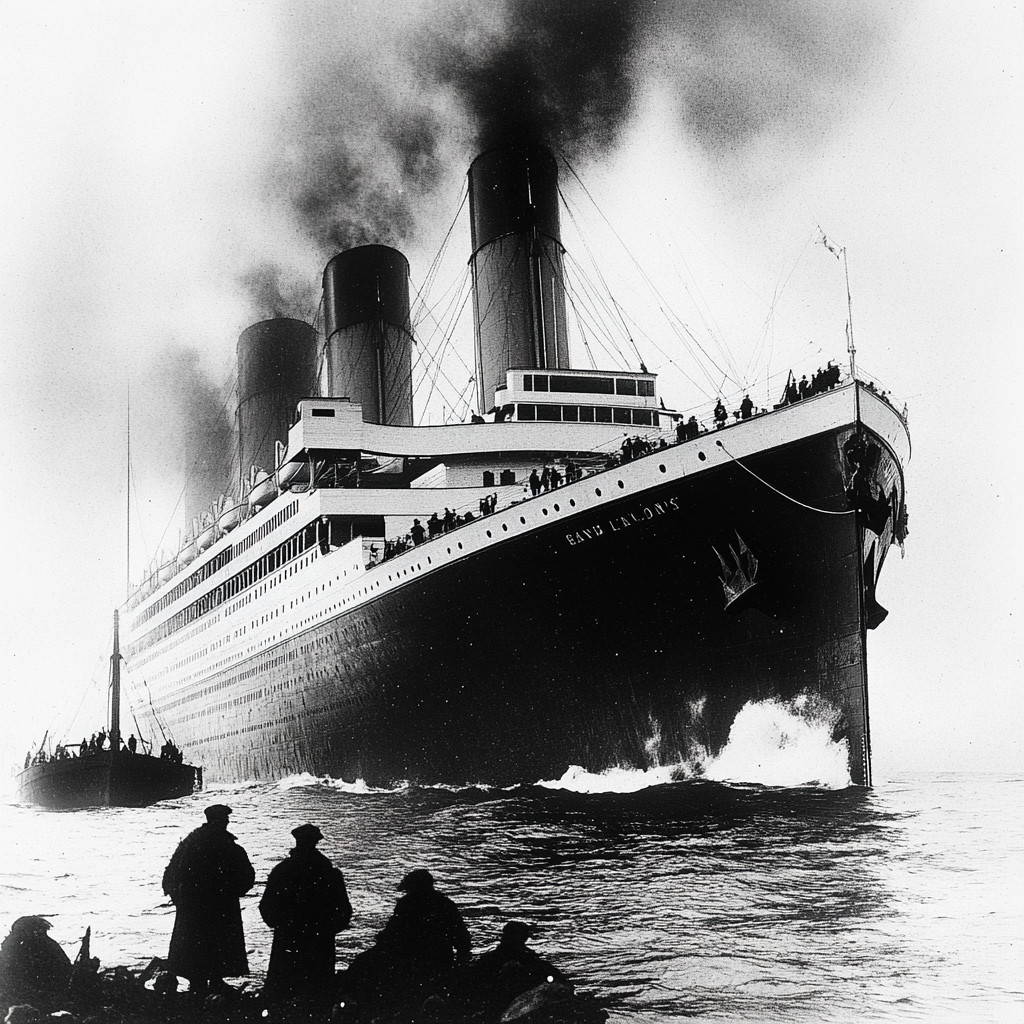Life has a way of throwing curveballs that leave us scratching our heads in disbelief. Sometimes, the stars align in such improbable ways that we’re left wondering if there’s more to the universe than meets the eye. Prepare to have your mind blown as we dive into seven of the most jaw-dropping coincidences that have actually occurred throughout history. These events defy explanation and will challenge your perception of reality. From eerie predictions to impossible encounters, these coincidences will make you question whether fate has a twisted sense of humor or if there’s an unseen force at play in our world.
1. The Titanic’s Chilling Literary Prophecy
In a twist of fate that seems almost too incredible to be true, an English author named Morgan Robertson penned a novella in 1898 that would later be hailed as a chilling premonition of one of history’s greatest maritime disasters. Titled “Futility, or the Wreck of the Titan,” Robertson’s work of fiction described the tragic sinking of a luxury ocean liner named Titan after it struck an iceberg in the North Atlantic. The eerie similarities between Robertson’s fictional account and the real-life sinking of the Titanic 14 years later are nothing short of mind-boggling.
Both ships were described as “unsinkable,” both met their doom on a cold April night, and both lacked sufficient lifeboats for their passengers. The fictional Titan and the real Titanic were even similar in size and speed. This uncanny parallel between fiction and reality has led many to speculate about the nature of precognition and the mysterious workings of the human mind. Could Robertson have tapped into some sort of collective unconscious or future memory? Or was this simply a case of life imitating art in the most tragic way possible? Whatever the explanation, this literary coincidence remains one of the most compelling and unsettling examples of apparent prophecy in modern history.
2. The Cosmic Connection of Mark Twain and Halley’s Comet
Mark Twain, the legendary American author, had a lifelong fascination with Halley’s Comet. This celestial visitor, which graces our skies approximately every 75 years, played a remarkably poetic role in Twain’s life story. Born on November 30, 1835, Twain entered the world just two weeks after the comet’s appearance that year. Throughout his life, he maintained a strange connection to this cosmic phenomenon, often joking about its significance.
In a twist of fate that seems almost too perfect to be true, Twain famously predicted his own demise would coincide with the comet’s next return. “I came in with Halley’s Comet in 1835. It is coming again next year, and I expect to go out with it,” he declared in 1909. True to his word, Twain passed away on April 21, 1910, just one day after Halley’s Comet reached its perihelion (closest approach to the Sun) during its 1910 appearance. This cosmic coincidence has captivated imaginations for over a century, leaving us to wonder about the mysterious synchronicities that sometimes occur between human lives and celestial events.
3. The Eerie Tale of Edgar Allan Poe’s Prophetic Novel
In a chilling example of life imitating art, Edgar Allan Poe’s 1838 novel “The Narrative of Arthur Gordon Pym of Nantucket” contained a disturbing scene that would later play out in real life with uncanny similarity. In Poe’s fictional tale, four shipwrecked sailors, driven to desperation by hunger, draw lots to decide who among them should be sacrificed and eaten. The unfortunate victim of this grim lottery is a young cabin boy named Richard Parker.
Fast forward to 1884, nearly half a century after Poe penned his novel, when a real-life yachting disaster unfolded off the coast of Africa. The Mignonette, a small yacht, sank during a voyage from England to Australia. The four-man crew escaped in a lifeboat but found themselves stranded at sea without food or water. In a horrifying turn of events that mirrored Poe’s fiction, three of the men decided to kill and eat the weakest among them to survive. The victim? A 17-year-old cabin boy named Richard Parker. This macabre coincidence has left many wondering about the nature of artistic inspiration and the possibility of precognition. Was Poe’s novel a mere flight of fancy, or did he somehow tap into a future event? The parallels between fiction and reality in this case are so striking that they continue to perplex and fascinate to this day.
4. The Founding Fathers’ Synchronized Departure
In a coincidence that seems almost too poetic to be true, two of America’s most revered Founding Fathers, John Adams and Thomas Jefferson, both breathed their last on July 4, 1826 – exactly 50 years after the signing of the Declaration of Independence. These two giants of American history, who had once been close friends, then bitter rivals, and finally reconciled correspondents in their twilight years, passed away within hours of each other on the nation’s golden jubilee.
Adams, unaware that Jefferson had died earlier that day, reportedly uttered his final words: “Thomas Jefferson survives.” The synchronicity of their deaths on such a significant date in American history has long been viewed as a profound symbol of their shared legacy and the enduring spirit of the nation they helped to create. This remarkable coincidence doesn’t end there, however. James Monroe, another Founding Father and the fifth President of the United States, also died on July 4th, albeit five years later in 1831. The odds of three out of the first five U.S. presidents dying on the same date, let alone the anniversary of the country’s independence, are astronomical. This confluence of events has led many to ponder whether there might be more to this than mere chance, perhaps suggesting a cosmic acknowledgment of these men’s roles in shaping American destiny.
5. The Uncanny Lives of Separated Twins
The story of Jim Lewis and Jim Springer, known as the “Jim Twins,” is a testament to the mysterious power of genetics and the inexplicable nature of coincidence. Separated at birth and raised by different adoptive families, these identical twins led parallel lives that defy logical explanation. When they finally reunited at age 39, they discovered a series of mind-boggling similarities in their life experiences.
Both Jims had been named James by their adoptive parents, both had married women named Linda, divorced, and then remarried women named Betty. They each had sons – one named James Alan and the other named James Allan. Both had owned dogs named Toy at different times in their lives. The coincidences extended to their habits and preferences: both smoked Salem cigarettes, drank Miller Lite beer, and had vacationed on the same Florida beach. They even shared similar occupations, with both working as sheriff’s deputies. The sheer number and specificity of these parallels have made the Jim Twins a fascinating case study in the nature-versus-nurture debate. Their story raises intriguing questions about genetic influence on personality and life choices, as well as the possibility of some deeper, unexplained connection between identical twins. The Jim Twins’ extraordinary tale continues to challenge our understanding of coincidence and the hidden forces that shape our lives.
6. The Hoover Dam’s Fateful Father-Son Connection
The construction of the Hoover Dam, one of America’s most iconic engineering marvels, is linked to a tragic coincidence that spans two generations. On December 20, 1922, J.G. Tierney, a surveyor working on the dam project, tragically fell from a barge and drowned in the Colorado River. His death marked the first fatality associated with the dam’s construction. Fast forward exactly 13 years to December 20, 1935, and in a cruel twist of fate, Patrick Tierney, J.G.’s son, became the last person to die during the dam’s construction when he fell from one of the intake towers.
The odds of a father and son both losing their lives on the same project, on the same date, 13 years apart, with one being the first casualty and the other the last, are astronomically small. This eerie coincidence has led many to speculate about the nature of fate and whether some cosmic force was at play. The Hoover Dam, which stands as a testament to human ingenuity and perseverance, also serves as a somber reminder of the human cost of such monumental projects. The Tierney family’s tragic connection to the dam’s history adds a poignant layer to its legacy, reminding us of the thin line between triumph and tragedy in great human endeavors. This coincidence continues to fascinate and unsettle those who learn about it, serving as a stark example of how chance and destiny can intertwine in the most unexpected ways.
7. The Unsinkable Violet Jessop’s Triple Maritime Miracle
Violet Jessop, a ship stewardess born in 1887, lived through a series of maritime disasters that defy belief. Her incredible story of survival earned her the nickname “Miss Unsinkable” and stands as one of the most remarkable examples of beating the odds in nautical history. Jessop’s unbelievable streak of luck (or perhaps unluck) began in 1911 when she was serving aboard the RMS Olympic, a luxury liner that collided with the British warship HMS Hawke. Although the Olympic sustained significant damage, it managed to limp back to port without any loss of life.
Undeterred by this close call, Jessop continued her career at sea. In 1912, she found herself aboard the ill-fated RMS Titanic on its maiden voyage. When the ship struck an iceberg and began to sink, Jessop helped to load women and children into lifeboats before eventually being ordered into lifeboat 16 herself. She survived the disaster, watching from the lifeboat as the great ship slipped beneath the waves. But Jessop’s brush with maritime disaster wasn’t over yet. During World War I, she served as a stewardess for the British Red Cross, and in 1916, she was aboard the HMHS Britannic when it struck a mine and sank in the Aegean Sea. Once again, Jessop survived, although she nearly lost her life when she was sucked under the ship’s keel by a propeller. The odds of one person surviving three major shipwrecks, including two of the most famous maritime disasters in history, are so astronomical that Jessop’s story seems more like fiction than fact. Her incredible tale of survival serves as a testament to human resilience and the unpredictable nature of fate, challenging our understanding of coincidence and luck.
These seven unbelievable coincidences serve as a reminder that reality can sometimes be stranger than fiction. From eerie premonitions to impossible survival stories, these events challenge our understanding of probability and fate. While skeptics may argue that in a world of billions of people, even the most unlikely events are bound to occur eventually, the specificity and timing of these coincidences continue to captivate our imaginations. Whether you view them as mere chance or evidence of some greater cosmic design, these remarkable stories remind us that the world is full of mysteries waiting to be unraveled. They invite us to keep our minds open to the extraordinary possibilities that exist in the seemingly ordinary fabric of our lives.

